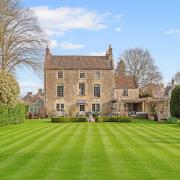It’s one of those mornings where the sky is the brightest of blues and everyone you meet seems to have an extra spring in their step. The waters of the Bristol Channel are crested with small white horses as the slight westerly breeze gives the early morning sea swimmers a helping hand as they swim in parallel with the pebbly beach. I’m admiring the unbroken view of Wales from the raised vantage point of the Driftwood Café, enjoying freshly-cooked scrambled eggs and locally-roasted coffee in the company of the café owner, Darren Taylor. He is telling me how the recent cliff falls further along the beach have caused road closures between the village and their neighbours in Watchet, ‘Some people are concerned that we’ll lose visitors but I remain positive in my outlook. We may be a ‘dead-end’ for a while but let’s use that to our advantage, we can build on it, we can promote Blue Anchor and Watchet as exclusive destinations, just like the coves in Cornwall. We’re special, we’re off the beaten track and that’s what makes us unique.’
Interestingly, if we turn the clock back 300 years or so, the somewhat isolated nature of Blue Anchor Bay was actually used to the advantage of a local group of ‘Owlers’, perhaps more familiarly known as smugglers. So-named as the majority of their ‘importing activity’ was partaken under nightfall, the 18th century Owlers recognised that Blue Anchor was a good spot for avoiding the Riding Officers who were stationed either side at Watchet and Minehead. Thankfully, the days of skullduggery are well behind us and the Driftwood Café prides itself on supporting local businesses instead. With sausages and eggs coming from Exmoor farmers, tea and coffee supplied from Somerset’s Miles Tea, and cakes and quiches all baked in-house, the offering here is fresh and celebrated by its regulars. Darren says, ‘On the face of it we may just be a 1930’s timber chalet on the beach, but we know that we have a loyal following because we don’t change things for change’s sake, we understand our context here over the past 90 years and have a very supportive community.’
Whilst Blue Anchor may, in the short term, be a little trickier than usual to reach by car let’s not forget that there are two other exciting ways to arrive in the village. The King Charles III England Coast Path brings a regular flow of hikers as they explore this stretch of historic coastline, and then there’s also the popular West Somerset Railway with steam trains stopping here several times a day. Blue Anchor station has, with thanks to Station Master Robin Wichard and the incredible team of volunteers, been meticulously restored to take you on a time-hop back to the 1930’s. Whether you explore the waiting room, ticket booking office or wander along the platform, it is without doubt one of the best-preserved stations along the line. Ticket Officer, Bryan Stevens says, ‘I’ve been volunteering for a while here and haven’t had a bad day yet! The West Somerset Railway is a community benefit and it gives so many people pleasure.’ I wander up to the signal box and meet Signalman, Chris Barker. On asking him why he loves to volunteer at Blue Anchor he leads me to a large window, ‘Take a look at that view across the Channel – that’s my very reason! Just remember, if you can see Wales it’s going to rain, and if you can’t see Wales, it’s raining already!’ With clear sight of the Welsh mainland, I bid him goodbye and just like everyone else in the village, step back out into the Blue Anchor sunshine with an added spring.
What’s in a name?
The true meaning of ‘Blue Anchor’ has been lost over time and there are differing trains of thought to its origin. Some locals believe that the name derives from the grey clay of the sea bed turning the anchors of moored ships blue. Another thought is that molluscs were harvested at Blue Anchor and the shells crushed to create the cloth dye, ‘Watchet Blue’ which was used in the 16th century. The third suggestion is linked to the Exmoor whortleberry – akin to a blueberry it has grown freely for centuries in the area and has a host of medicinal properties.
PAY A VISIT
Stay or Buy:
Blue Anchor House offers a series of apartments with garden access and sea views. One of the fully-equipped holiday lets also includes a hot tub where you can enjoy sunset views and see the steam train chug by. Hoseasons.co.uk
Hazlewood is a four-bedroom detached property with sea views. With AGA, conservatory and a large garden, this 1930’s home is close to Blue Anchor’s promenade and the West Somerset Railway. £650,000 (Wilkie May & Tuckwood)
Did you know?
Ancient folklore states that Blue Anchor villagers used to be tormented by a violent serpent who lived on Ker Moor. There are also tales of ‘Yeth Hounds’ who were said to steal the laughter from children. Spooky!




























